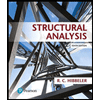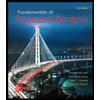
Structural Analysis
6th Edition
ISBN: 9781337630931
Author: KASSIMALI, Aslam.
Publisher: Cengage,
expand_more
expand_more
format_list_bulleted
Question

Transcribed Image Text:"A Newtonian fluid has viscosity that does NOT change."
True
False
Expert Solution
arrow_forward
Step 1
Using Newtonian fluid properties
Step by stepSolved in 2 steps with 1 images

Knowledge Booster
Learn more about
Need a deep-dive on the concept behind this application? Look no further. Learn more about this topic, civil-engineering and related others by exploring similar questions and additional content below.Similar questions
- The band in the figure below is stainless steel (coefficient of linear expansion = 17.3 ✕ 10−6°C−1; Young's modulus = 18 ✕ 1010 N/m2). It is essentially circular with an initial mean radius of 5.4 mm, a height of 4.4 mm, and a thickness of 0.51 mm. If the band just fits snugly over the tooth when heated to a temperature of 81°C, what is the tension in the band when it cools to a temperature of 37°C?arrow_forwardA 1-m long steel bar (E = 200 GPa) of 10 x10 mm dimension fixed at one end and free at the other end is heated to 90°C from initially 30°C. What is the normal stress, in MPa, induced in the system due to change in temperature? Use a = 12 x 10-6 per °C. Encode you answer in whole number. Round your answer to 0 decimal places.arrow_forwardA 4 meter long steel plate with a rectangular cross section (10 mm x 50 mm) is resting on a frictionless surface under the sun. The plate temperature is measured to be at 40°C. The plate is then moved into a cold room and is left to rest on a frictionless surface. After several hours, the plate temperature is measured to be 5°C. The steel has a modulus of elasticity equal to 200 GPa and a coefficient of thermal expansion equal to 1.1x10-5/°C. a. What is the length of shrinkage b. What tension load is needed to return the length to the original value of 4 meters? c. What is the longitudinal strain under this load?arrow_forward
- When a force involves direct contact between two bodies, such as a push or pull that you exert on an object with your hand, we call it a force. Contact force Long-range force Normal force Friction forcearrow_forward(1) Basic Concepts Show that a stress and a momentum flux have the same unit by showing that a force and the rate of momentum change or transfer have the same unit.arrow_forwardThere is no force on a beam, but the beam is subjected to a very large temperature difference above and below. As shown in the figure below, try to calculate the vertical displacement of the midpoint of the beam, assuming that the temperature coefficient of the entire beam is a = 11.7×10^-6 °F. Tip: See Mechanics of Materials for Beam Deformation Geometryarrow_forward
arrow_back_ios
arrow_forward_ios
Recommended textbooks for you

 Structural Analysis (10th Edition)Civil EngineeringISBN:9780134610672Author:Russell C. HibbelerPublisher:PEARSON
Structural Analysis (10th Edition)Civil EngineeringISBN:9780134610672Author:Russell C. HibbelerPublisher:PEARSON Principles of Foundation Engineering (MindTap Cou...Civil EngineeringISBN:9781337705028Author:Braja M. Das, Nagaratnam SivakuganPublisher:Cengage Learning
Principles of Foundation Engineering (MindTap Cou...Civil EngineeringISBN:9781337705028Author:Braja M. Das, Nagaratnam SivakuganPublisher:Cengage Learning Fundamentals of Structural AnalysisCivil EngineeringISBN:9780073398006Author:Kenneth M. Leet Emeritus, Chia-Ming Uang, Joel LanningPublisher:McGraw-Hill Education
Fundamentals of Structural AnalysisCivil EngineeringISBN:9780073398006Author:Kenneth M. Leet Emeritus, Chia-Ming Uang, Joel LanningPublisher:McGraw-Hill Education
 Traffic and Highway EngineeringCivil EngineeringISBN:9781305156241Author:Garber, Nicholas J.Publisher:Cengage Learning
Traffic and Highway EngineeringCivil EngineeringISBN:9781305156241Author:Garber, Nicholas J.Publisher:Cengage Learning


Structural Analysis (10th Edition)
Civil Engineering
ISBN:9780134610672
Author:Russell C. Hibbeler
Publisher:PEARSON

Principles of Foundation Engineering (MindTap Cou...
Civil Engineering
ISBN:9781337705028
Author:Braja M. Das, Nagaratnam Sivakugan
Publisher:Cengage Learning

Fundamentals of Structural Analysis
Civil Engineering
ISBN:9780073398006
Author:Kenneth M. Leet Emeritus, Chia-Ming Uang, Joel Lanning
Publisher:McGraw-Hill Education


Traffic and Highway Engineering
Civil Engineering
ISBN:9781305156241
Author:Garber, Nicholas J.
Publisher:Cengage Learning